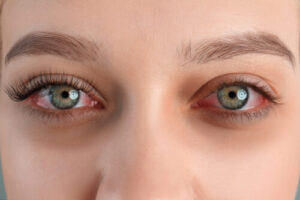Bacterial conjunctivitis
Understand the causes of bacterial conjunctivitis, and explore treatments and hygiene practices to prevent this contagious eye condition.


Seasonal Allergic Conjunctivitis (SAC)
It is also known as Hay Fever Conjunctivitis, is a seasonal affliction that occurs from spring to fall. It is often associated with allergic rhinitis and is characterized by intermittent symptoms that relate to the presence of seasonal allergens, such as pollen from trees, grasses, and weeds. SAC is estimated to be the most frequent form of ocular allergy, affecting a significant portion of the population during specific times of the year when these allergens are most prevalent.1Perennial Allergic Conjunctivitis (PAC)
On the other hand, is present throughout the year. It shares similar symptoms with SAC but is caused by constant exposure to perennial allergens like dust mites, molds, and animal dander. PAC is a chronic condition that leads to persistent and often mild allergic symptoms, which can result in permanent discomfort if not properly managed.1;2Both SAC and PAC significantly impact the quality of life of affected individuals, particularly children and adolescents, who are more commonly afflicted by these conditions. Although allergic conjunctivitis usually does not affect vision, it causes significant symptomatology, including itching, redness, and watery eyes, which can substantially reduce the quality of life of people.2
Understanding the nature of allergic conjunctivitis, including its types and symptoms, is crucial for effective management and alleviation of this condition. By recognizing the triggers and implementing appropriate measures, individuals suffering from allergic conjunctivitis can significantly improve their comfort and overall quality of life.2
What can cause Allergic Conjunctivitis?
Allergic conjunctivitis, a common yet often bothersome condition, arises from our body’s overreaction to substances it mistakenly considers harmful.
This reaction leads to inflammation of the conjunctiva, the thin membrane that lines the inside of the eyelids and covers the white part of the eye, causing symptoms such as itching, redness, and watering. Understanding what triggers allergic conjunctivitis is crucial for managing and reducing its symptoms.1

The primary culprits behind allergic conjunctivitis are airborne allergens, which can be broadly categorized into two types: seasonal and perennial.
Recognizing the types of allergens responsible for allergic conjunctivitis is the first step in managing this condition. For those with SAC, monitoring pollen counts and limiting outdoor activities during peak pollen seasons can help reduce exposure.2
In summary, allergic conjunctivitis is an exaggerated immune response to airborne allergens, classified into seasonal and perennial types based on the nature of the allergens involved. By understanding these triggers, individuals can adopt strategies to minimize their exposure and manage the symptoms of allergic conjunctivitis more effectively.
What are the symptoms of Allergic Conjunctivitis?
Allergic conjunctivitis is recognized primarily by two hallmark symptoms: redness and itching.
These symptoms are key indicators of the condition and serve as the body’s response to allergens. However, the symptoms of allergic conjunctivitis do not end there.
Individuals suffering from this condition may also experience a range of additional symptoms, including:
These symptoms collectively contribute to the discomfort and visual disturbance associated with allergic conjunctivitis. The identification and understanding of these symptoms are crucial for effective management and relief of the condition.
By recognizing these symptoms early, individuals can seek appropriate treatment and management strategies to alleviate discomfort and minimize the impact of allergic conjunctivitis on their daily lives.1
How to diagnose an Allergic Conjunctivitis problem?
Diagnosing allergic conjunctivitis means understanding it as part of a range of hypersensitivity disorders that affect the eye’s surface and can show up in different ways.
Symptoms often overlap with other allergies, especially rhinitis (hay fever), so ophthalmologists and allergists need to work together for accurate diagnosis and treatment.
The diagnosis is based mainly on patient history, visible signs, and symptoms, along with tests to identify specific allergen sensitivities. This approach highlights the need for a standardized naming and classification system that combines eye care and allergy criteria to make diagnosis easier and improve treatment strategies for eye allergies.1
What treatments are available for Allergic Conjunctivitis?
Let’s try to understand the available treatments for allergic conjunctivitis, a common yet bothersome condition that affects many of us, especially during those peak allergy seasons.
If you’ve ever experienced that annoying itchiness, redness, and swelling in your eyes, you’re not alone.
The good news? There are effective ways to combat these symptoms and be comfortable again:

First off, a fundamental step in managing allergy conjunctivitis is identifying and avoiding the allergens that trigger your symptoms. It might sound simple, but it’s incredibly effective. Whether it’s pollen, dust mites, or pet dander, steering clear of these irritants can significantly reduce your discomfort. This proactive approach can make a world of difference, minimizing your reliance on medication and enhancing your overall quality of life. 1
However, we all know that completely avoiding allergens is easier said than done. That’s where medication comes into play. Over-the-counter and prescription options abound, tailored to soothe your symptoms and restore your eye health. Antihistamines are a popular choice, offering quick relief by blocking the histamine reaction that causes itching and redness.
For those who need a bit more support, mast cell stabilizers are another excellent option. They work by preventing the release of histamine and other inflammatory substances in the first place, offering a more long-term solution to those pesky allergy symptoms. Think of them as the peacekeepers of your immune system, maintaining order and preventing flare-ups before they start. 1
In cases where symptoms persist or are particularly severe, your doctor might recommend multi-action agents or corticosteroids.1
And let’s not forget about eye drops. For many, they’re a go-to solution for instant relief. Today’s eye drops come in various formulations, including antihistamines and mast cell stabilizers, providing targeted relief right where you need it. Plus, with the advent of preservative-free options, they’re gentler on your eyes than ever before, ensuring that you can use them while minimizing the risk of irritation. 1
It’s important to remember that managing allergy conjunctivitis is a personal journey. What works for one person might not work for another, so it’s all about finding the right combination of avoidance strategies and treatments that suit your specific needs.
In general, don’t hesitate to ask your pharmacist for advice if you have any eye symptoms.
On the other hand, if you experience one or more of these symptoms, you should see an eye specialist as a matter of urgency; -Moderate,-Severe pain, -Intense sensitivity to light, -Decreased vision, -Flashes of light, -Dark spots, -Sensation of a foreign object in the eye, -Trauma (injury, contusion, acid burn etc.), -Persisting or worsening symptoms despite appropriate treatment.
